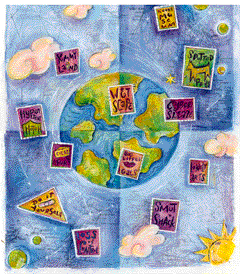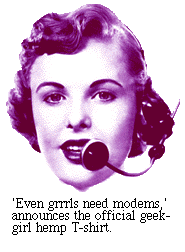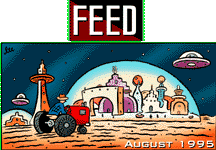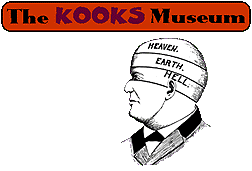
[ Features | MetroActive Contents ]
Around the Web in 80 Clicks
promises a revolution in
personal publishing and
communications as revol-
utionary as Gutenberg's
printing press
By John Whalen The World Wide Web
The World Wide Web
Illustration by Susan Gross
A few years ago, a zine like geekgirl (headquartered in the publishing
backwater of Newtown, Australia) might have reached a select audience
of several hundred people via snail mail or a regional electronic
bulletin board. But rosie's World Wide Web version of
geekgirl--loaded with sleek color graphics and other
eye-boggling production values--is read by 80,000 persons a month on
six continents.
In fact, rosie and a vanguard of independent, back-pocket publishers
may be riding the crest of a communications phenomenon as culturally
significant as Gutenberg's printing press. And I'm not referring to the
hype about businesses and corporations peddling their wares in a
gargantuan online cybermall.
On the World Wide Web, documents and pictures that reside on computer
servers directly linked to the World Wide Web can be linked together
using hypertext, an innovative, if
somewhat awkward, method of hopping from one document to another at the
click of a mouse button. Using "browser"
software like Mosaic or Netscape, which went public with a
multimillion-dollar bang last week, on your home computer you can
access Web computer documents and pictures from around the world,
instantaneously.
For example, if you're reading this article on the Web, you can click on the highlighted word Louvre and be whisked away to
a computer server in Paris filled with text and digitized masterpieces.
(After your virtual tour, please come back and finish this article.)
Of course, the Web is thick with advertisers, hucksters, fast-buck
dreamers and Fortune 500 companies staking claims in the multimedia
land. But there's also a secondary landscape dense with populist
communications and do-it-yourself publishing ventures: electronic zines
("e-zines"), rants, screeds, manifestoes, shameless odes to oneself and
one's hobbies and obsessions.
How to build your own Web site
Autonomous modes of self-expression--good, bad, beautiful and ugly--are
pouring onto the Web with amazing speed. At its best, the Web has
fostered a slew of bright, independent e-zines like geekgirl,
FEED,
Bad Subjects, and
CTHEORY, which are
thriving as online, homemade alternatives to the Time-Warners, Rupert
Murdochs, and Disney-Cap Cities/ABCs of the world.
At its worst, the Web can be the digital equivalent of vanity license
plates: the unemployed Silicon Valley engineer peddling his typo-ridden
rsum; the university secretary who maintains the physics department Web
page, and helpfully includes a picture of her Nautilus-enhanced
physique; the poet manqu who invites you to submit to his turgid verse;
the proud parents who digitize their four-year-old's Crayola murals,
extending the reach of their refrigerator magnets around the world.
Luckily, there is enough quality content out there to keep you happily,
and perhaps compulsively, linking for days on end.
Virtual globetrotting is hardly the most impressive
aspect of the Web. What really makes the Web so amazing is that it
enables almost anyone to do two things that were formerly unheard of.
First, become a publisher, without access to a fortune of Hearstian
proportions. (How accessible is Web publishing? I created a
Web e-zine on a budget of about one dollar a day.)
Second, create meaningful associations--hypertext links--between your
words and pictures and other swatches, volumes and regions of
information on the growing Internet. In other words, you can
essentially contribute your two-bytes worth to a sprawling worldwide
encyclopedia of knowledge.
These are no small accomplishments. What the Web does best is
contradict journalist A.J. Liebling's classic axiom that "freedom of
the press is guaranteed only to those who own one." Via the Web, anyone
with a modicum of hardware and a minimum of technical knowledge can,
for the first time in the history of publishing, more or less "own" a
press.
The technology does an end run around the traditional barriers to
self-publishing: the high cost of equipment, newsprint and most
importantly, distribution.The person who publishes a seat-of-the-pants
underground e-zine using a home Macintosh has access to the same
audience that Time-Warner reaches via
Pathfinder, its Web site.
Although desktop publishing already gave self-publishers a chance to
own their own press at minimal expense, the Web offers an instant
world-wide distribution channel--which costs practically nothing. It is
this remarkable feature that makes the Web a truly revolutionary
medium.
The new do-it-yourself digital media has even been compared to the
proliferation of popular political pamphlets and newspapers of the late
18th-century. During the American Revolutionary period, new ideas
stormed the colonies--from the bottom up, thanks to the upsurge in
small presses. Between 1783 and 1801, 450 newspapers sprang up in the
former colonies.
With access to small presses, radical thinkers like Tom Paine managed
to transform the thoughts and habits of many new Americans. Paine, says
John Katz, Wired magazine's media critic, was "one of the first to use
media as a powerful weapon." According to Katz, Paine ought to be
considered the spiritual father of the Web and Internet. Paine, writes
Katz, "invented contemporary political journalism" and almost
single-handedly created "a mass reading-public aware for the first time
of its right to encounter controversial opinions and to participate in
politics."
Katz elaborated in an e-mail interview: "Publishing was not the
province of the elite in Paine's time, quite the opposite. Jefferson
and others were dismayed by how many loud and common voices there were.
An illiterate farmer called 'The Laborer' had others write his thoughts
on agricultural policy, and they popped up as pamphlets all over the
colonies. Today, only on the Net could someone get his or her message
out like that."
A couple latter-day inheritors of Paine's tradition would certainly
include the editors of
CTHEORY and
Bad Subjects, two
progressive journals on the Web that critique politics, culture and
technology--the kind of thing that's hard to find on your local
magazine racks.
Of course, politics on the Web are all over the map--you'll find as
many lefty viewpoints as you will Clinton-bashing sites (the
Whitewater and the Vince
Foster pages, for example), virtual clubhouses for gun nuts, and
right-wing militia calls to arms. Unlike the mainstream press, the Web
is a deep reservoir filled with distinct points of view.
From CTHEORY, I linked to the
Hakim Bey Web page, where a
diligent nouveau publisher has posted hypertext versions of the
contemporary anarchist/philosopher's essays and poems (in English
andFrench). This page is a fitting tribute to the electronic
legacy of Paine. Bey (a pseudonym) writes about creating revolutionary
new societies using public computer networks to nurture "Temporary
Autonomous Zones" (TAZ), furtive enclaves that operate outside of the
control of the state and the mainstream, almost like "pirate utopias."
This deliciously subversive idea neatly encapsulates the potential of
the Web to connect series of parallel underground communities and
salons--real alternatives to commercialized, centralized media
cultures.
No wonder many a digital publisher bandies about Bey's terminology when
waxing dreamy about the Web. "There's nothing inherently democratic
about the Net," says geekgirl rosie x., " 'cept for us Web publishers
who create temporary and permanent autonomous zones. The Net subtly
subverts the mainstream and its rigid mind-set."
Certainly, not all sites on the Web are as intellectually challenging
and civically uplifting as Paine's Common Sense or Bey's TAZ.And
if they were, the Web would be a dull place, indeed. Some of the
sweetest sites on the Web are as individualistic and quirky as a
private tour of an eccentric hobbyist's basement work room.
I find myself gawking at lurid back alleys like the
Internet Crime Archive, a
collection of graphics and factoids about serial killers; delving
through the legions of Web sites devoted to nutball science and way-out
politics (Steamshovel
Press; Kooks
Museum); occasionally monitoring the Web's much-maligned
pornography sites (for the articles, of course); strolling through
not-always-successful experiments in "interactive writing"--readers
become writers, contributing shaggy dog prose and occasionally sublime
passages to cooperative literature experiments like
Hypertext Hotel or
interactive salons like Bianca's Smut
Shack.
No one knows exactly how many e-zines and other
experiments in grass-roots publishing inhabit the Web. But the growth
of the Web itself has been nothing less than explosive. According to
the latest estimates, two years ago only 130 "host" computers
maintained World Wide Web "sites." A year later that number had
multiplied almost ten-fold, and today's estimates place the number of
host computers at upward of 12,000, and there are some 6 million
computer users with access to the Web.
The number of individual Web sites is actually much higher, because
many server operators divide their telecommunications bandwidth and
lease it to others. One recent guesstimate put the number of specific
Web pages at upward of several million.
Some hypernauts--those who greet the Web and its hypertext architecture
as a kind of second coming--go so far as to argue that the interlinked
knowledge network of the World Wide Web will "democratize" journalism
and literature, and knowledge in general.But wait! That's not all. Some
postmodernist Web-philes also argue that hypertext will force media to
reflect multiple points of view, nonlinear thought patterns,
nontraditional narrative text forms.
Of course, like past hosannas to the liberating powers of computer
technology, much of the ado about Web hypertext is a tad premature.For
starters, the Web is barely 6 years old, and is hampered by
still-developing technical standards and the strained capacity of
telecommunications lines.
There's also the argument that the Web, with its top-down information
(you read what the editor wants you to read, just like in an "analog"
magazine), is less democratic than an online electronic bulletin board
system (or BBS). On a BBS, according to cyber columnist Craig
McLaughlin, "The content is constantly being changed by the people who
use it."
rosie x. disagrees. BBSes are not more democratic or decentralized
than Web sites, she says. In fact, many BBS systems, according to
rosie, operate like a too-small town, with all its stifling
tendencies. "Sometimes a BBS can become like a neighborhood where
everybody's backyard joins on to everyone else's," she explains."They
give crap advice, and you can't see them. So there's something to be
said for the disparate points of resistance on the Web," which tend to
work against what she calls the "emerging net-oligarchy," those
so-called experts who get all the attention on BBSes, to the detriment
of newcomers.
But the Web has plenty of other limitations. As in any new
communications medium, there's still a lot of creative groping going
on. Meanwhile, the big commercial interests that have staked a claim in
the rush to the Internet want to use the Web as a new repository for
old-style advertising, an electronic sluice box for recycled editorial
content or nothing more than a glorified mail-order catalog.
But, advises digital communitarian Howard Rheingold, author of The
Virtual Community, one of the first books to look at electronic
sociology, "Concentrate not on the 98 percent crap" that constitutes
the content of the Web. "Everything is 98 percent crap. Focus on the 2
percent genius that can only emerge from the grass roots, and not from
the top down."
A example of the creme of the Web is
FEED, a thoughtful, slickly
produced media journal out of New York City. Conceived and edited by
Steven Johnson, a freelance journalist who contributes to the
Guardian of London, FEED uses the hypertext medium better
than just about any other Web site.
In the premiere issue, Johnson convened a panel of hypertext
aficionados and skeptics, and asked them to speculate on the "cultural
consequences of electronic text." The panelists included neo-Luddite
Sven Birkerts, author of The Gutenburg Elegies, a meditation on
the decline of reading, and Carolyn Guyer, an author of hypertext
fiction and co-founder of the Web's Hypertext Hotel, an
experiment in interactive fiction--"readers" can add their own prose to
an evolving storyline.
Panelists contributed (asynchronously) to the FEED colloquy, and
then inserted--by means of hypertext links--their own reactions to
their fellow panelists' commentary. The resulting debate--comments
within comments within comments--was a bit dizzying and sometimes
frustratingly digressive. It was also extremely fascinating--and
certainly much more provocative than anything you'd encounter in a
Time or Newsweek article.
"Pixels are the malleable substance some of us have wished print could
be," wrote Guyer. "Pixels are things you pick up and move, remove,
change, add to. The nature of the technology transforms the meaning of
the word, reader."
To this comment, Birkerts attached (or, rather, editor Johnson
attached, Birkerts being a neo-Luddite) his startled response: "Those
of us who are bent on expression ... are likely to be nervous about the
'more active and involved reader.' ... I have a primitive view of
authorship. I see it--etymologically, too--as a claiming of authority.
I don't believe in collaborative creativity, at least not on the scale
made possible by hypertext."
And thus was launched a secondary debate over what Guyer calls the
authorial "fear of loss of control"--the very phenomenon that many
journalists and writers find so troubling about the Internet and
especially the Web.
Experiencing FEED, I marveled at the fact Johnson had discovered
a particularly effective way to illustrate just what the panelists were
talking about. Form followed function in a way that wouldn't be
possible in a traditional magazine. Alongside the dialogue, Johnson ran
a "threaded" bulletin board discussion where "readers," or whatever
they should be called, could inject their own comments.
After feeding on FEED for a few hours, I fired off an e-mail
missive to Johnson, asking him about the potential for a new,
interactive journalism on the Web.
"The Web," he wrote back, "is brimming with links right now--but
they're mainly links to other Web sites. That's cool enough, but it
only skims the surface, really. The real innovation, it seems to me, is
the ability to create these multidimensional documents, with a number
of voices occupying the same space."
Carolyn Guyer, a postmodernist through and through, agrees. In her
electronic response to my queries, she spoke of hypertext as a
epistemological tool capable of much more than truly public
publishing. In theory, she said, hypertext has the capacity to
transform our very thought patterns.
Western civilization, she explained, has always viewed the world in
dualistic terms: male/female, life/death, good/evil, etc. With the
nonlinear linking capabilities of hypertext, Guyer believes that it is
possible for a complex multiplicity of viewpoints to find expression.
Consequently, hypertext undermines our Western belief that nature and
society must be controlled--can be entirely controlled.
Hypertext reflects a more realistic, ambiguous, relative view of the
world. This notion, of course, smacks of the kind of relativism that
drives academic conservatives bonkers.
Guyer has coined a word to describe the cognitive disorientation that
comes with this new, complex form of expression: "buzz-daze." What she
means by that is basically the confusion of multiple points of
view--information overload, if you will. You could argue that buzz-daze
is unavoidable, salubrious even in our "multi-tasking," relativistic
society. But it is a disconcerting feeling for someone raised on the,
well, "tyranny" of the canonical book.
I can relate. I had been calling the sensation "hypertext static"--the
cacophony of too much information, too many egos sounding off, too many
doorways opening before me. I told Guyer that I'm often bothered by the
brain-inflaming information overload that can accompany Web
surfing--all those pages, bristling with hypertext links, data detours,
informational cul de sacs. It's a bit like getting lost in a new
suburban development on those windy, cutely named streets.
Guyer shot back with a comment that sounds uncomfortably like
psychoanalysis: "It's only info-overload if you feel you must
read every damned one of those links in order to know everything that's
there. This is a very common reaction to hypertext of any kind. We've
been trained to think of knowledge as being whole and complete, neatly
packaged between two covers."
But, she adds, tying the idea of the reader's perceived loss of control
to the author's anxiety over loss of control, "no one can ever know
everything. In fact, we can't even know most things for certain, have
it down pat and be sure it won't change. To artificially construct an
authoritative, correct version is pretty lame when you look at the
fuller possibilities of 'knowing.' "
Much as I love the idea of publishing on the Web, I do
know what Birkerts means when he complains about the erosion of
authorial authority. It's unsettling to have readers coming back at you
with immediate criticism. And this ambivalence isn't an entirely
selfish, hide-preserving crotchet.
For instance, how reliable is anonymous information on the Net? People
depend on the imprimatur of a newspaper or a publisher for some sense
that time andexpertise have been applied to a text before it is
released. Obviously, the New York Times has extreme, if subtle,
biases, but it does a great deal of intensive fact-checking. Who's
fact-checking on the Web?
Media critic Katz, for one, doesn't share my misgivings: "I think the
journalist," he said, "needs to be abruptly knocked off of his or her
high media horse. ... The New York Times has an important role
to fill. But the Times reporter should have an e-mail address on
his or her story, and interact with readers and be more accountable for
arrogance, error and elitism than they now are."
In the new digital media, with its decentralized sources of
information, Katz said, "journalists will still have more power than
others, but less than they used to. Interactive media are ascending,
passive media are declining."
Play hypertext leapfrog on the World Wide Web, and you'll get a sense
that Katz's warning to the press corps isn't just wishful thinking. To
be sure, the mainstream media has joined the dash to settle the Web,
and the Time Warners and Mercury
Centers have more moneyto throw around than, say, a tiny startup
like FEED. But their editorial offerings often pale in
comparison to the creative outbursts of independent publishers.
Still, even Katz worries about the monolithic media devouring the
innovative little sites: "I consider that to be the greatest danger to
this culture. Eastern media and money interests have always owned and
co-opted these individualistic movements. But the nature of the
software is such that it's hard to monopolize the Net in the way
newspapers and TV have monopolized traditional media."
FEED editor Steven Johnson agrees that the decentralized nature
of Web publishing will prevent monopolies from seizing the Net. He sees
the two popular models of the future of the Web co-existing--the
democratic vision of a nonlinear, two-way medium alongside the
commercial goal to create a giant cybermall.
The good news? The Web, he explained, will probably look less like the
model of commercial television than it will the music business. "The
corporate behemoths, will have their cybermalls, but there will also be
a thriving independent community--much like the indie-rock circuit that
has appeared in the last ten years. But the smaller operators will have
access to a bigger market, since the distribution expenses of Web
publishing are virtually nonexistent.
"So there will be much more parity between the big fish and the little
fish," adds Johnson. "That doesn't mean that the big fish will just
wither away, as the Web utopians would have it. It just means that the
big fish will have a harder time swallowing the little ones."
For geekgirl rosie x., the next-to-nonexistent costs of publishing on
the Web means that diverse, original voices will probably continue to
flourish. "Even though there are over four million indexed Web pages,
there's nothing else like geekgirl in the whole world. Oh, shucks, now
I'm getting all emotional"
Spoken like a true geekgirl.
Rosie x. is a geekgirl--and proud of it. Every three months, she
distributes another issue of her homegrown magazine--also called geekgirl--via the
Internet. geekgirl--the electronic magazine--is a lively
techno-culture review produced mostly on rosie's bedroom PC, with the
help of friends around the globe.

To see what I mean, just spend a few
minutes exploring the World Wide Web--the network of computers within
the Internet that forms a kind of decentralized global kiosk onto which
anyone with a modicum of technical know-how can post his or her own
"page," or personalized collection of words and pictures. 

The Web of the People 
Web-Tide
FEED Your Head 
The Interactive Byline 
John Whalen is the co-author of
The 50 Greatest Conspiracies
of All Time
This page was designed
and created by the Boulevards
team.
Copyright
© 1995 Metro Publishing and Virtual Valley, Inc.